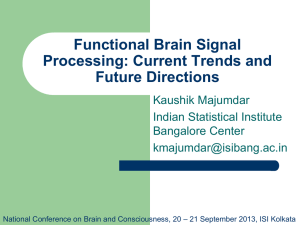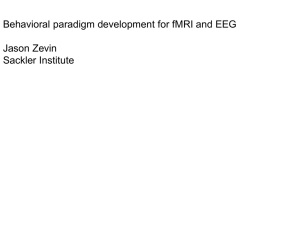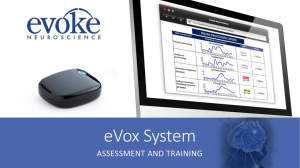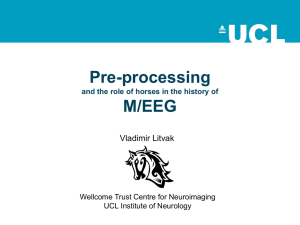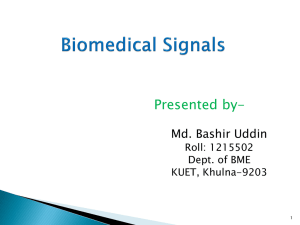Mental effort while conceptual tasks solving
advertisement
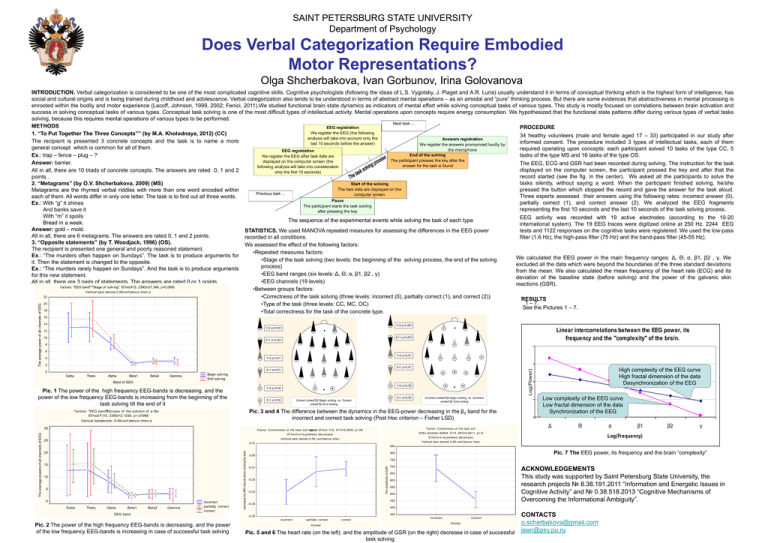
SAINT PETERSBURG STATE UNIVERSITY Department of Psychology Does Verbal Categorization Require Embodied Motor Representations? Olga Shcherbakova, Ivan Gorbunov, Irina Golovanova 16 14 1>2 p<0,001 1>2 p<0,001 10 2>1 p<0,001 2>1 p<0,001 8 6 1>2 p<0,01 1>2 p<0,01 4 2 2>1 p<0,01 2>1 p<0,01 0 Delta Theta Alpha Beta1 Beta2 Gamma Begin solv ing End solv ing Band of EEG 1>2 p<0,05 1>2 p<0,05 Pic. 1 The power of the high frequency EEG-bands is decreasing, and the power of the low frequency EEG-bands is increasing from the beginning of the task solving till the end of it 2>1 p<0,05 2>1 p<0,05 Correct solved*β2 Begin solving .vs. Correct solved*β2 End solving Incorrect solved*β2 begin solving .vs. Incorrect solved*β2 End solving Pic. 3 and 4 The difference between the dynamics in the EEG-power decreasing in the β2 band for the incorrect and correct task solving (Post Hoc criterion – Fisher LSD) f actors: "EEG band"*" Success of the solution of a task ". Ef f ect: F(10, 2390)=2,1238, p=,01988 Vertical barsdenote - 0,95 conf idence interv als 30 25 Factor: Correctness of the task solv ing, urrent c ef f ect: F(2, 917)=5,0635, p=,00650 Factor: Correctness of the task solv ing Ef f ectiv e hy pothesis decomposition Wilks lambda=,93554, F(13, 687)=3,6411, p=,00001 Vertical bars denote 0,95 conf idence interv als Ef f ectiv e hy pothesis decomposition High complexity of the EEG curve High fractal dimension of the data Desynchronization of the EEG Low complexity of the EEG curve Low fractal dimension of the data Synchronization of the EEG Δ Θ α β1 β2 γ Log(Frequency) Vertical bars denote 0,95 conf idence interv als 0,01 850 15 10 5 0 Delta Theta Alpha Beta1 Beta2 Gamma incorrect partially correct correct EEG band 750 -0,01 -0,02 -0,03 700 ACKNOWLEDGEMENTS This study was supported by Saint Petersburg State University, the research projects № 8.38.191.2011 “Information and Energetic Issues in Cognitive Activity” and № 0.38.518.2013 “Cognitive Mechanisms of Overcoming the Informational Ambiguity”. 650 600 550 500 450 -0,04 400 350 -0,05 incorrect Pic. 2 The power of the high frequency EEG-bands is decreasing, and the power of the low frequency EEG-bands is increasing in case of successful task solving Pic. 7 The EEG power, its frequency and the brain “complexity” 800 0,00 The amplitude of GSR 20 decrease the RR interval when solving the task The average powers of all channels of EEG Linear intercorrelations between the EEG power, its frequency and the "complexity" of the brain. 12 Log(Power) The average power of all channels of EEG INTRODUCTION. Verbal categorization is considered to be one of the most complicated cognitive skills. Cognitive psychologists (following the ideas of L.S. Vygotsky, J. Piaget and A.R. Luria) usually understand it in terms of conceptual thinking which is the highest form of intelligence, has social and cultural origins and is being trained during childhood and adolescence. Verbal categorization also tends to be understood in terms of abstract mental operations – as an amodal and “pure” thinking process. But there are some evidences that abstractiveness in mental processing is enrooted within the bodily and motor experience (Lacoff, Johnson, 1999, 2002; Fenici, 2011).We studied functional brain state dynamics as indicators of mental effort while solving conceptual tasks of various types. This study is mostly focused on correlations between brain activation and success in solving conceptual tasks of various types. Conceptual task solving is one of the most difficult types of intellectual activity. Mental operations upon concepts require energy consumption. We hypothesized that the functional state patterns differ during various types of verbal tasks solving, because this requires mental operations of various types to be performed. Next task ... METHODS EEG registration PROCEDURE We register the EEG (the following 1. “To Put Together The Three Concepts”” (by M.A. Kholodnaya, 2012) (CC) 34 healthy volunteers (male and female aged 17 – 33) participated in our study after analysis will take into account only the Answers registration The recipient is presented 3 concrete concepts and the task is to name a more informed consent. The procedure included 3 types of intellectual tasks, each of them last 10 seconds before the answer) We register the answers pronounced loudly by general concept which is common for all of them. required operating upon concepts: each participant solved 10 tasks of the type CC, 5 the microphone EEG registration End of the solving Ex.: trap – fence – plug – ? tasks of the type MS and 16 tasks of the type OS. We register the EEG after task data are The participant presses the key after the displayed on the computer screen (the Answer: barrier. The EEG, ECG and GSR had been recorded during solving. The instruction for the task answer for the task is found following analysis will take into consideration displayed on the computer screen, the participant pressed the key and after that the All in all, there are 10 triads of concrete concepts. The answers are rated 0, 1 and 2 only the first 10 seconds) record started (see the fig. in the center). We asked all the participants to solve the points . tasks silently, without saying a word. When the participant finished solving, he/she 2. “Metagrams” (by O.V. Shcherbakova, 2009) (MS) Start of the solving The task data are displayed on the pressed the button which stopped the record and gave the answer for the task aloud. Metagrams are the rhymed verbal riddles with more than one word encoded within Previous task ... computer screen Three experts assessed their answers using the following rates: incorrect answer (0), each of them. All words differ in only one letter. The task is to find out all three words. Pause partially correct (1), and correct answer (2). We analyzed the EEG fragments Ex.: With “g” it shines The participant starts the task solving representing the first 10 seconds and the last 10 seconds of the task solving process. And banks save it after pressing the key With “m” it spoils EEG activity was recorded with 19 active electrodes (according to the 10-20 The sequence of the experimental events while solving the task of each type Bread in a week. international system). The 19 EEG traces were digitized online at 250 Hz. 2244 EEG Answer: gold – mold. STATISTICS. We used MANOVA repeated measures for assessing the differences in the EEG power tests and 1122 responses on the cognitive tasks were registered. We used the low-pass All in all, there are 6 metagrams. The answers are rated 0, 1 and 2 points. recorded in all conditions. filter (1.6 Hz), the high-pass filter (75 Hz) and the band-pass filter (45-55 Hz). 3. “Opposite statements” (by T. Woodjack, 1996) (OS). We assessed the effect of the following factors: The recipient is presented one general and poorly reasoned statement. •Repeated measures factors: Ex.: “The murders often happen on Sundays”. The task is to produce arguments for We calculated the EEG power in the main frequency ranges: Δ, Θ, α, β1, β2 , γ. We •Stage of the task solving (two levels: the beginning of the solving process, the end of the solving it. Then the statement is changed to the opposite. excluded all the data which were beyond the boundaries of the three standard deviations process) Ex.: “The murders rarely happen on Sundays”. And the task is to produce arguments from the mean. We also calculated the mean frequency of the heart rate (ECG) and its •EEG band ranges (six levels: Δ, Θ, α, β1, β2 , γ) for this new statement. deviation of the baseline state (before solving) and the power of the galvanic skin •EEG channels (19 levels) All in all, there are 3 pairs of statements. The answers are rated 0 or 1 points. reactions (GSR). f actors: "EEG band"*"Stage of solv ing". Ef f ect : F(5, 2390)=27,349, p=0,0000 •Between groups factors: Vertical bars denote- 0,95conf idence interv als 22 •Correctness of the task solving (three levels: incorrect (0), partially correct (1), and correct (2)) RESULTS 1 – 7. 20 •Type of the task (three levels: CC, MC, OC) See the Pictures 1 – 7. 18 •Total correctness for the task of the concrete type. partially correct Answer correct Incorrect Correct Answer Pic. 5 and 6 The heart rate (on the left) and the amplitude of GSR (on the right) decrease in case of successful task solving CONTACTS o.scherbakova@gmail.com jean@psy.pu.ru



